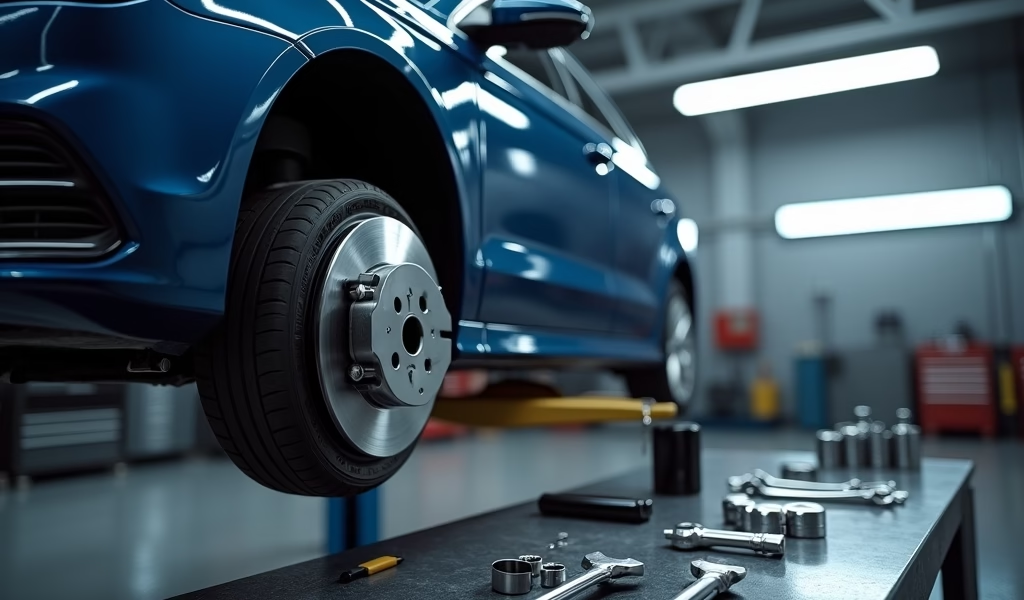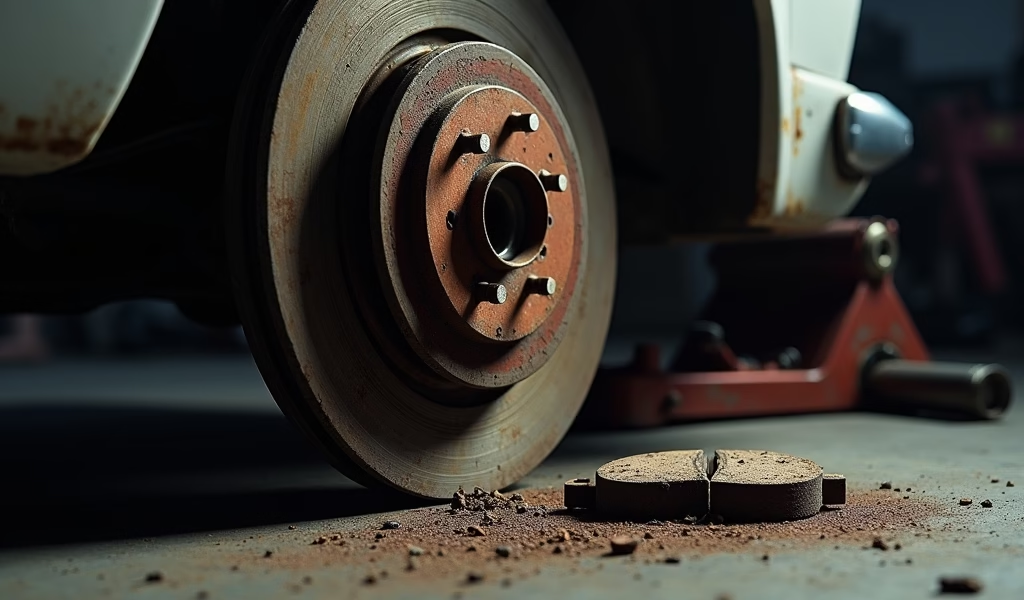Overview
Brake pad replacement typically costs $100-$400 per axle depending on vehicle type, location, and service provider, with DIY options offering savings of $70-$250 per axle for those with mechanical experience. Regular maintenance is essential for safety, as brake pads generally last 30,000-70,000 miles, and drivers should watch for warning signs like squealing noises, vibration, and increased stopping distance to avoid more expensive damage to rotors and other components.
Table of Contents
- Understanding Brake Pad Costs: What You’re Really Paying For
- Average Cost Factors for Brake Pad Replacement
- DIY vs. Professional Brake Pad Replacement: Cost Comparison
- Signs You Need Brake Pad Replacement
- Types of Brake Pads and Their Price Points
- Saving Money Without Compromising Safety
- How Often Should You Replace Brake Pads?
- Conclusion
- Frequently Asked Questions
Understanding Brake Pad Costs: What You’re Really Paying For
When it comes to how much to change brake pads, the answer isn’t always straightforward. As a mechanic with over 15 years in the field, I’ve seen folks get surprised by brake service costs more times than I can count. The truth is, brake pad replacement costs vary widely—anywhere from $100 to $400 per axle—depending on several factors that most drivers aren’t aware of.
Think of brake pads as the unsung heroes of your vehicle’s safety system. They create the friction needed to stop your car, converting kinetic energy into heat. When you press that brake pedal, you’re relying on these relatively small components to bring thousands of pounds of metal to a stop—sometimes in emergency situations.
The actual brake pads themselves typically cost between $30 and $150 per axle, but that’s just part of what you’re paying for. Labor generally runs $80 to $200 per axle, depending on your location and the shop you choose. Some vehicles simply take longer to work on due to their design, which translates to higher labor costs.
Additional components might need replacement alongside your brake pads. Rotors often need resurfacing or replacement (adding $100-$300 per axle), and calipers might need rebuilding or replacement in some cases ($100-$400 each). These additional services can dramatically affect your brake pads replacement cost.
Average Cost Factors for Brake Pad Replacement
Let’s break down the major factors that influence how much you’ll pay for brake pad replacement:
Vehicle make and model plays a significant role in pricing. Luxury and performance vehicles like Mercedes, BMW, or Audi typically require more expensive brake components and specialized knowledge. For example, replacing brake pads on a Toyota Camry might cost $150-250 per axle, while the same service on a BMW 5-series could run $350-500.
Your geographic location affects pricing substantially. Labor rates in metropolitan areas tend to be 20-40% higher than in rural areas. A brake job that costs $200 in a small town might run $300 in a major city due to higher overhead costs for the shop.
The type of service facility you choose makes a big difference. Dealerships typically charge premium rates (often 30-50% more than independent shops), while chain stores might offer competitive pricing but with varying quality. Independent shops often strike a good balance between reasonable costs and quality workmanship.
According to AAA’s automotive repair statistics, brake pad replacement ranks among the most common repair services, with nationwide average costs reflecting regional economic differences.

DIY vs. Professional Brake Pad Replacement: Cost Comparison
For the mechanically inclined, DIY brake pad replacement can offer substantial savings. Let’s compare the costs:
A DIY brake pad replacement typically costs $30-$150 per axle for parts alone. You’ll need brake pads, which vary in quality and price, plus supplies like brake cleaner, anti-squeal compound, and possibly new hardware. One-time tool investments might include a jack, jack stands, lug wrench, C-clamp or caliper tool, and various wrenches and sockets—though many can be rented from auto parts stores.
Professional replacement costs include both parts and labor, ranging from $150-$400 per axle depending on your vehicle and location. While this is significantly more than the DIY approach, you’re paying for expertise, proper equipment, and peace of mind.
The real question is whether the savings justify the DIY route. If you have no mechanical experience, brake work isn’t the best place to start your DIY journey. Brakes are critical safety components, and improper installation can have serious consequences. However, if you’re comfortable working on cars and follow proper procedures, DIY brake work is certainly doable.
Time is another consideration. What might take a professional 1-2 hours could take a DIY-er 3-4 hours on their first attempt. Factor in your hourly worth when calculating true savings.
Many professional shops also offer warranties on their brake work—typically 12 to 24 months or a specific mileage. This additional protection isn’t available with DIY repairs, though part manufacturers may offer limited warranties on the components themselves.
Signs You Need Brake Pad Replacement
Knowing when to replace your brake pads can save you from costlier repairs down the road. Here are the telltale signs I tell my customers to watch for:
Squealing or screeching noises when braking are usually the first warning. Most brake pads include a small metal indicator that creates this noise when pads are getting thin. Don’t ignore this sound—it’s deliberately annoying to get your attention!
Grinding noises indicate a serious problem. This means your brake pads have worn completely through, and metal is grinding against metal. Continuing to drive in this condition will damage your rotors, dramatically increasing your brake pad replacement cost.
Vibration in the brake pedal often indicates warped rotors, which can result from worn brake pads generating excessive heat. The longer you drive with worn pads, the more likely you’ll need rotor replacement too.
Increased stopping distance is a subtle but dangerous sign. If your vehicle takes longer to stop than it used to, your brake pads may be worn past their effective range.
Visual inspection is the most definitive check. Most brake pads start with about 10-12mm of material and should be replaced when they reach 3-4mm thickness. Many vehicles allow you to see brake pad thickness through the wheel spokes, or a mechanic can check during routine maintenance.
The warning light on your dashboard (if equipped) shouldn’t be ignored. Some vehicles have sensors that trigger a dashboard indicator when pads reach minimum thickness. Consider this your final warning before more expensive damage occurs.
According to the National Highway Traffic Safety Administration, brake-related issues contribute to approximately 22% of crashes where vehicle factors are cited. Regular maintenance isn’t just about saving money—it’s about safety.
Types of Brake Pads and Their Price Points
Not all brake pads are created equal, and the type you choose significantly affects both performance and cost:
Organic brake pads (also called non-asbestos organic or NAO) are the most affordable, typically ranging from $30-$50 per axle. These pads are made from materials like rubber, glass, and fiber bound together with resin. They’re quiet and easy on rotors but wear faster and don’t perform well at high temperatures, making them best suited for normal daily driving.
Ceramic brake pads cost more, usually $70-$150 per axle, but offer several advantages. They produce less dust, run quieter, and last longer than organic pads. They also dissipate heat well, providing consistent performance. For most drivers, ceramic pads offer the best balance of performance, longevity, and value.
Semi-metallic pads contain 30-65% metals (steel, copper, iron) mixed with friction modifiers and fillers. Priced between $40-$80 per axle, these pads offer excellent stopping power and heat dissipation. However, they tend to be noisier and harder on rotors. These are ideal for drivers who need reliable performance in varied conditions.
Fully metallic pads are primarily used in racing applications. They’re the most expensive ($100-$300 per axle) and offer exceptional performance at high temperatures but are typically too noisy and abrasive for street use.

Saving Money Without Compromising Safety
After seeing thousands of brake jobs over my career, I’ve gathered some solid advice for saving money without cutting corners on safety:
Regular inspections can catch brake wear early, preventing the cascading damage that occurs when pads wear completely through. Have your brakes checked at every oil change or at least twice a year. Most shops offer free brake inspections, making this a no-brainer.
Consider mid-range brake pads rather than the cheapest or most expensive options. The price-performance sweet spot is usually in the middle, where you get reasonable longevity without premium pricing. For most drivers, high-end performance pads offer no practical advantage.
Shop around and get multiple quotes. Brake service pricing can vary dramatically between shops, even in the same area. Call at least three reputable shops for quotes, making sure they’re quoting the same service (pads only vs. pads and rotors). Many shops offer free estimates.
Ask about warranty coverage. Some shops offer lifetime warranties on brake pads for a slightly higher upfront cost, which can save money over time if you plan to keep your vehicle for several years.
Consider timing your brake service with other maintenance. Some shops offer discounts when combining brake work with other services like wheel alignments or tire rotations.
Keep an eye out for specials and coupons. Many shops run seasonal brake specials, and manufacturer rebates on parts are common. Joining an auto parts store’s rewards program can yield significant savings for DIYers.
If you’re quoted for rotor replacement, ask if resurfacing is an option. In many cases, rotors can be machined rather than replaced, saving $100 or more per axle. However, this isn’t always possible if the rotors are already too thin or severely damaged.
How Often Should You Replace Brake Pads?
The frequency of brake pads replacement varies widely based on several factors. Let’s look at what determines brake pad lifespan:
Driving habits have the biggest impact on brake pad life. Aggressive drivers who frequently brake hard will wear through pads much faster than those with smoother driving styles. City drivers typically replace pads twice as often as highway drivers due to the frequent stop-and-go nature of urban driving.
Vehicle weight and type matter significantly. Heavier vehicles put more strain on braking components, wearing them faster. A compact car might go 70,000 miles on a set of pads, while a heavy SUV might need replacement at 30,000-40,000 miles.
The quality of the pads plays a major role. Premium pads often last 40-60% longer than economy options, making them more cost-effective despite higher upfront costs. The old adage “you get what you pay for” definitely applies to brake components.
Environmental conditions affect brake wear. Mountainous regions with lots of downhill driving increase brake usage, as do areas with frequent stop-and-go traffic. Coastal regions may experience accelerated wear due to salt and moisture exposure.
For most vehicles under typical driving conditions, expect to replace brake pads every 30,000 to 70,000 miles. However, I’ve seen variations from as little as 15,000 miles (performance cars driven hard) to over 100,000 miles (light vehicles with highway miles and conservative driving).
Rather than focusing solely on mileage, pay attention to the warning signs we discussed earlier. Your vehicle will tell you when it needs new brake pads if you’re listening—both literally and figuratively.
Conclusion
Understanding how much to change brake pads helps you budget properly and avoid unexpected expenses. While costs typically range from $100 to $400 per axle depending on your vehicle and chosen service provider, being an informed consumer can help you manage these expenses without compromising safety.
Remember that brakes are perhaps the most critical safety system in your vehicle. While it’s smart to look for value, this isn’t the area to cut corners or defer maintenance. The cost of brake pad replacement is minimal compared to the potential consequences of brake failure or the additional expenses that come from letting pad wear progress too far.
Whether you choose the DIY route or professional service, regular inspection and timely replacement of brake pads is an investment in both your vehicle’s longevity and your personal safety. By understanding the factors that influence pricing and recognizing the signs of wear, you can make informed decisions that keep both your vehicle and your wallet in good shape.
Frequently Asked Questions
How long does it take to replace brake pads professionally?
For most vehicles, professional brake pad replacement takes 1-2 hours per axle. Complex vehicles or those requiring additional brake component replacements may take longer.
Can I replace just one brake pad?
No, brake pads should always be replaced as a complete axle set (both wheels). Replacing a single pad creates dangerous braking imbalances.
Will I need new rotors when changing brake pads?
Not necessarily, but rotors often need resurfacing or replacement when changing pads. Your mechanic should measure rotor thickness and surface condition to determine this.
What’s the difference between front and rear brake pad costs?
Front brake pads typically cost more and wear faster because they handle 60-80% of braking force. Rear brake systems are often simpler and less expensive to service.
Can I drive with grinding brakes?
Absolutely not. Grinding indicates metal-on-metal contact that’s damaging your braking system and compromising safety. Seek immediate repair if you hear grinding.

